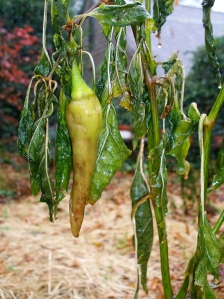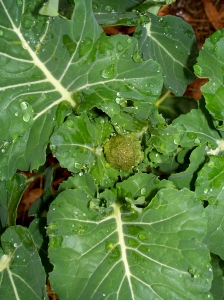
Adorable hat my mom made
It stands to reason that someone who grows vegetables, keeps chickens, cans and preserves, and loves to cook should also be able to sew and knit and crochet and such. But I think the fiber arts gene skipped a generation for me. My mother is a skilled seamstress–she made many of my clothes growing up (actually, I was wearing her creations well into adulthood and still have a few skirts she made for me in my closet). She tried to teach me, but I had neither the patience nor the ability. Plus, I’m left-handed, and left-handed scissors hadn’t been invented when I was learning to use scissors, and so I can’t use them today, which means at best I cut badly with my right hand. You have to cut a straight line to sew. Forget it.
She also was–remains–a mad knitter. I have a beautiful black mohair sweater she knitted decades ago that I still wear. And a white mohair cardigan that shrunk to the perfect, stylish size a few years ago when she accidentally machine-washed it, then tossed it in a pile bound for charity (“I’ll take that!”). Recently she made a hat for me that is so adorable that several of my friends asked for one, too. When she tried to teach a teenaged me to knit, though, we both got frustrated. She couldn’t show me what to do left-handed, and I couldn’t work in mirror-image to her hands.

The incredible shrinking cardigan, made by my mom
It’s satisfying, however, to see the rising numbers passionate knitters recently, especially among my generation and younger. I love to watch them do their thing–it draws your attention to each little inch of pattern. I love the deftness of motion in their hands, the rhythmic clack of the needles. I love the smell of a hand-knitted garment: a mammal combination of lanolin and the scent of the knitter, her lotion, soap, skin–it’s the odor of life itself. And what a transformation to go from yarn to garment, to know someone had her fingers on every single stitch. All that with nothing more than a couple of sticks! I am in awe of my childhood friend and now knitting guru, Theresa, who colors her own fiber with natural dyes and spins it into beautiful yarns.
Over the Thanksgiving holiday, I was cleaning out a closet and found a long-forgotten impulse purchase from several years back of some yarn and a pair of needles (I think it was all a dollar at Target). On a whim, I pulled it out, found a YouTube video that showed me how to cast on and do a basic stitch, and I was off and knitting. I would make a scarf! And soon would come sweaters and hats and maybe even some cute mittens. Visions of urban homestead self-sufficient beauty danced in my head.
I took my project along to the mountains on Thanksgiving day and proudly showed my mother my progress. She politely stifled a guffaw (but then couldn’t contain a cackle when I dropped three stitches at once). She saw I was struggling with needles that were too small and gave me some larger ones. She told me my bouclé yarn was impossible, but it was what I had, and so I persisted.

"Knitting" my "Thing"
I posted an update to Facebook: “Allison is learning herself to knit.” The response was overwhelming–I had no idea knitters were such evangelists for their craft. I received all sorts of good and enthusiastic advice and encouragement, including from Theresa, who also told me to ditch the difficult yarn (I didn’t).
I kept at it obsessively. It was relaxing and meditative–that simple, repetitive motion, the gradual emergence of a . . . thing . . . as I worked. But then I noticed that somehow my “thing” was getting wider with every row. I was adding stitches, and I couldn’t figure out why. And then I saw the holes. My thing was Swiss cheese.
I took my thing home and unraveled it and started all over. Four times. I tried different yarn I had gotten from Mom. I couldn’t hold the needles with my clumsy right hand. I spent hours at it, lost sleep over it. Relaxing and meditative gave way to stressful and frustrating. Almost coming unraveled myself, I quit. Bagged the whole thing to give to Mom later on. On Facebook: “Allison is not a knitter.” Lots of consoling comments from the knitter friends.

My scarf-in-progress, plus a beautiful bag my mother knitted and felted.
And then. A few evenings back I passed the little knitting shop in Decatur, and I couldn’t help myself. I stopped in, and the next thing I knew I was leaving the store with a pair of #9 needles and some rich brown 50 percent wool/50 percent llama hair from Peru. That night I started all over–about five times, but then I was suddenly getting the hang of it. No more dropped or added stitches (the yarn really was the problem, but it was also the way I was holding it) and I now have about five inches of a scarf to go with the hat my mom made. It isn’t elegant or beautiful, even, and I’m slow and awkward, but the rows are (pretty much) the same size, and the holes are few and tiny–not terribly noticeable. And it’s relaxing and meditative again.
There may never sweaters or hats or mittens from my needles, but I feel like I’m in on a secret now. It’s the knowledge of a skill, the assuredness of competence. And that, I think, is part of the reward of the Southern Urban Homestead lifestyle–knowing how to do things, to make something of value (if not quite beauty) from so very little, to provide.















